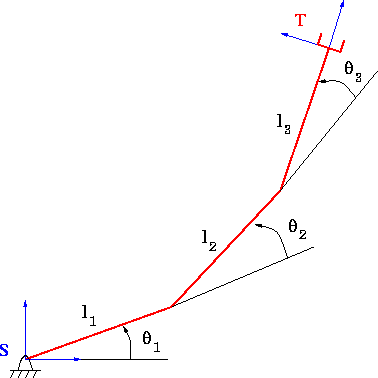University of Notre Dame
Aerospace and Mechanical Engineering
AME 469: Introduction to Robotics
Homework 6
B. Goodwine
Spring, 2001 |
Issued: March 21, 2001
Due: March 28, 2001 |
Unless otherwise indicated, all the problems are from the
course text, Craig, Introduction to Robotics. Unless
otherwise indicated, each problem is worth 10 points.
- 5.18
Note: the problem is only concerned with the linear
part of the rigid body velocity.
- 5.19
- For the three link planar robot illustrated in in the
Figure,
- determine the forward kinematics from the base frame,
S, to the tool frame T including the orientation of the
tool frame (in class, I only did (x,y) for the two
link manipulator);
- compute the Jacobian;
- determine at least two singular configurations; and,
- (optional - 10 points extra ) modify the animation code presented in
class to drive the mechanism from the starting
configuration given in the code along a desired trajectory
that takes it near one of the workspace interior
singularities. Verify that large joint velocities occur
near the singularity.

- In Homework 2, you determined the forward kinematics for
the mechanism in problem 3.18, Figure 3.38. Assume that we
are interested in the (x,y,z) location of the end
effector (note that you will have to add a frame at the
end effector -- before your forward kinematic computations
only went to the frame attached to the last link at the axis
of rotation). Assume that each joint angle is 30o.
- Compute the Jacobian for this system; and
- determine at least one singular configuration.
- What is the direction of the maximum mechanical
advantage?
- What is the direction of the maximum velocity amplitude?
- In Homework 2, you determined the forward kinematics for
the mechanism in problem 3.20, Figure 3.40. Assume that we are
interested in the (x,y,z) location of the end effector.
Assume that d1 = 0 and that the two revolute joint angles
are 30o
- compute the Jacobian for this system; and,
- determine at least one singular configuration.
- What is the direction of the worst velocity amplitude?
- What is the direction of the worst mechanical advantage?
- In Homework 3, you determined the forward kinematics for
the mechanism in problem 3.21, Figure 3.41. Assume that we are
interested in the (x,y,z) location of the end effector.
Assume that d1 = 2, d2 = 1 and
d3 = 4.
- What is the direction of the maximum force fidelity?
- What is the direction of the maximum velocity fidelity?
Last updated: March 21, 2001.
B. Goodwine (jgoodwin@nd.edu)
